That Farquharson flagged down a passing car and travelled to his ex-wife’s home instead of calling emergency services to the crime scene, and later watched on as others dove into the dam looking for his three sons was, almost immediately, seen by police not just as odd behaviour, but as a sign of something more sinister.
The Chamberlains arriving at Darwin Court with their solicitor, Stuart Tipple, in 1982.Credit: Nigel McNeil
Contrary to what many people believe, our adversarial justice system is not a search for the truth. It is a gladiatorial contest with increasing reliance on complex science. The more complex it is, the more likely the accused is to be disadvantaged.
Biases formed by police and prosecutors because of how someone experiencing acute grief behaves – which can vary greatly from person to person – is important. But the primary fault in the case of the Chamberlains and other recent miscarriages like Kathleen Folbigg was the so-called expert evidence.
Our legal system does not require expert evidence being presented to a jury to be scientific or be peer-reviewed. Instead, we largely leave it up to jurors, who are not equipped to determine the validity or accuracy of highly complex science.
Within a growing sector of the scientific community, this evidence is referred to as “junk science”, and it causes wrongful convictions that irreversibly shape people’s lives. In the cases of the Chamberlains and Folbigg, it led to them being found guilty of crimes they did not commit.

Lindy Chamberlain-Creighton, her husband, and Stuart Tipple (left) attending the fourth inquest into her daughter’s disappearance in 2012.Credit: Fairfax
When police recreated the sinking of Farquharson’s car as part of their investigation, the first two tests bore results that matched his version of events. However, a third test that has since been heavily criticised for being under different conditions and that contradicted Farquharson’s story, was also played to the jury three times at both trials.
Farquharson has always maintained that a severe coughing fit caused him to black out while at the wheel of the car. Despite medical records of this rare condition, known as cough syncope, dating back to 1876, prosecutors challenged not just his story, but the condition itself.
Most accused simply cannot match the resources of police and the prosecution. It’s akin to turning up to a gunfight armed with a knife.
As soon as they were charged in early 1982, the Chamberlains applied for legal aid – a laborious and time-consuming process. Nine months later, and just two days before the first trial commenced, legal aid was granted, but was refused to cover any costs incurred in the preparation. Fortunately, their church covered some of these expenses, but much of the work was done pro bono. Without that help, they would never have been exonerated.
Even now, people still tell me the system got it right in the end for the Chamberlains. My response is always the same: No, the system completely failed them.
Our jury system is not working, and our appellate system rarely corrects them.
How an accused behaves may be informative to a small degree, but when used as the primary basis for a case, and then paired with junk science, the consequences are long-reaching and devastating for all involved, not least our so-called justice system.
Stuart Tipple is a solicitor and author. He represented Michael and Lindy Chamberlain in their trials, appeals and inquests.

